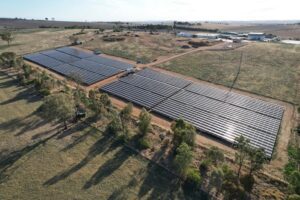Australian battery manufacturer Li-S Energy says it has developed a twenty-layer battery cell using its third-generation (GEN3) semi-solid state lithium sulfur technology that packs in more energy density and is safer and more reliable than its previous offering.
Manufactured at the company’s Phase 2 facility in Geelong, Victoria, the new cells are built using a low-flammability electrolyte which the company says will make them safer than traditional lithium sulfur and lithium-ion battery cells.
Li-S Energy says its third-generation battery has some major advantages over its previous, second-generation iteration, including a major (45%) increase in volumetric energy density. That increase, according to the company, is thanks to the use of a lower-porosity cathode material.
Using its patented Li-nanomesh technology, the cells incorporate Boron Nitride Nanotubes (BNNTs) into the cell construction to reduce dendrite growth, which improves both safety and the life cycle of the battery.
That’s because dendrites, projections of metal that build up on the lithium surface of cells and penetrate into the solid electrolyte, eventually cross from one electrode to the other, shorting the cell.
Dendrites have been a major roadblock to the commercial development of long-lived lithium-sulfur batteries, which have the potential to hold more than double the energy density of the more commonly-used lithium-ion batteries.
Robin Leveson, the chairman of PPG Group, the ASX-listed company that owns a 50.23% share in Li-S Energy, says the announcement is a major step in the development of next generation lithium-based batteries.
“Li-S Energy’s development of its twenty-layer battery cell using semi-solid state lithium sulfur technology is a major achievement and highlights the progress made by Li-S over the past 12 months,” he said.
“The potential to significantly reduce the physical size of the battery packs through the 45% increase in volumetric energy will undoubtedly be of significant commercial interest to high value partners in sectors such as drones and eAviation.
“These pivotal results are a testament to the Li-S team and further validate the patent protected Li-nanomesh technology and benefits of incorporating Boron Nitride Nanotubes (BNNTs) into the cell construction.”
Levison said the batteries were proving themselves in lab conditions.
“The new GEN3 cells are currently demonstrating a gravimetric energy density in our laboratories of over 400 Wh/kg, and a volumetric energy density of 540 Wh/l,” he said.
“Compared to current Lithium ion cells this is nearly double the gravimetric energy density and comparable for volumetric energy density. In practical terms this means that our cells are now the same physical size as existing Lithium ion batteries but half the weight.
“Our development team is currently working to develop the cell cycle testing and characterisation results to produce an industry standard datasheet on the new twenty-layer cells.”
“The development of these new battery cells is another validation of the strength of our scientific and technical teams, and our collaboration with Deakin University and other Australian and international institutions,” said Li-S Energy CEO Lee Finniear.
“This outcome demonstrates the strength of our progress over the last year. In the coming months we look forward to commencing the production of commercial samples for our partners.”








